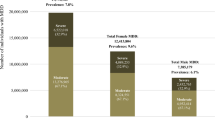Abstract
Objectives
The purpose was to determine the short-term course of depression among dialysis patients in Saudi Arabia and identify baseline characteristics that may influence course.
Methods
Thirty-nine dialysis patients in Jeddah, SA, were identified with subthreshold, minor, or major depressive disorders using the Structured Clinical Interview for Depression (SCID) and followed up at 6 and 12 weeks using the Longitudinal Interview and Follow-up Evaluation (LIFE) schedule. Depressive symptoms were tracked using the Hamilton Depression Rating Scale (HDRS). Patient characteristics measured at baseline included demographic, psychosocial, physical health, and treatment factors.
Results
Of the 20 patients with major or minor depressive disorder, eight (40 %) fully remitted by 6 weeks and an additional three patients remitted over the next 6 weeks, leaving 45 % with significant depressive symptoms persisting beyond 12 weeks. Subthreshold disorders followed a similar course (42 % with persistent symptoms). Few patients received treatment for depression. Those with more education, severe health problems, poorer psychological function, more severe depressive symptoms, or a family psychiatric history were less likely to remit. Similar factors predicted change in depressive symptoms assessed by HDRS, especially high medical co-morbidity, severe illness, and overall poor psychological functioning.
Conclusions
Nearly one-half of depressed dialysis patients in Saudi Arabia continue to have significant symptoms beyond 12 weeks of follow-up, few of whom were treated. Specific characteristics at baseline identify depressed dialysis patients at greater risk of persistent symptoms who need treatment.

Similar content being viewed by others
Notes
Although higher baseline Global Assessment of Functioning (GAF) scores predicted worse outcomes (based on the “between-subjects” F value in the repeated-measures ANOVA), the time by GAF interaction (“within subjects”) effect was also significant (p = .036) meaning that this relationship was a complex one. Repeating the analyses using the mixed procedure in SAS, however, did not replicate this within-subjects finding.
References
Grassman A, Bioberge S, Moeller S, Brown G (2005) ESRD in 2004: global overview of patient numbers, treatment modalities and associated trends. Nephrol Dial Transplant 20:2587–2593
Lysaght MJ (2002) Maintenance dialysis population dynamics: current trends and long-term implications. J Am Soc Nephrol 13(Suppl 1):S37–S40
Coresh J, Selvin E, Stevens LA et al (2007) Prevalence of chronic kidney disease in the United States. JAMA 298:2038–2047
Abboud O (2006) Incidence, prevalence, and treatment of end-stage renal disease in the Middle East. Ethn Dis 16(2 Suppl 2):S2-2–S2-4
Ferrari AJ, Charlson FJ, Norman RE et al (2013) Burden of depressive disorders by country, sex, age, and year: findings from the Global Burden of Disease Study 2010. PLoS Med 10(11):e1001547
Kessler RC, Berglund P, Demler O et al (2003) The epidemiology of major depressive disorder: results from the National Comorbidity Survey Replication (NCS-R). JAMA 289:3096–3105
Kitchell MA, Barnes RF, Veith CR, Okimoto JT, Raskind MA (1982) Screening for depression in hospitalized geriatric medical patients. J Am Geriatr Soc 30:174–177
Koenig HG, George LK, Peterson BL, Pieper CF (1997) Depression in medically ill hospitalized older adults: prevalence, correlates, and course of symptoms based on six diagnostic schemes. Am J Psychiatry 154:1376–1383
Rosemann T, Backenstrass M, Joest K, Rosemann A, Szecsenyi J, Laux G (2007) Predictors of depression in a sample of 1,021 primary care patients with osteoarthritis. Arthrit Rheum 57(3):415–422
Wulsin LR, Vailant GE, Wells VE (1999) A systematic review of the mortality of depression. Psychosom Med 61:6–17
Kimmel PL, Peterson RA, Weihs KL et al (2000) Multiple measurements of depression predict mortality in a longitudinal study of chronic hemodialysis outpatients. Kidney Int 57:2093–2098
Lopes AA, Bragg J, Young E et al (2002) Dialysis Outcomes and Practice Patterns Study (DOPPS). Depression as a predictor of mortality and hospitalization among hemodialysis patients in the United States and Europe. Kidney Int 62:199–207
Farrokhi F, Abedi N, Beyene J, Kurdyak P, Jassal SV (2014) Association between depression and mortality in patients receiving long-term dialysis: a systematic review and meta-analysis. Am J Kidney Dis 63(4):623–635
Kimmel PL, Phillips TM, Peterson RA et al (1998) Immunologic function and survival in hemodialysis patients. Kidney Int 54:245–254
Mapes DL, Lopes AA, Satayathum S et al (2003) Health-related quality of life as a predictor of mortality and hospitalization: the Dialysis Outcomes and Practice Patterns Study (DOPPS). Kidney Int 64:339–349
Rosenkranz MA, Jackson DC, Dalton KM, Dolski I, Ryff CD, Singer BH, Muller D, Kalin NH, Davidson RJ (2003) Affective style and in invo immune response: neurobehavioral mechanisms. PNAS 100(19):11148–11152
Pecoits-Filho R, Bárány P, Lindholm B, Heimbürger O, Stenvinkel P (2002) Interleukin-6 an independent predictor of mortality in patients starting dialysis treatment. Nephrol Dial Transplant 17:1684–1688
Kiecolt-Glaser JK, Preacher KJ, MacCallum RC, Atkinson C, Malarkey WB, Glaser R (2003) Chronic stress and age-related increases in the proinflammatory cytokine IL-6. PNAS 100(15):9090–9095
Howren MB (2009) Lamkin Dm Suls J. Associations of depression with C-reactive protein, Il-1, and Il-6: a meta-analysis. Psychosom Med 71:171–186
McDade-Montez EA, Christensen AJ, Cvengros JA, Lawton WJ (2006) The role of depression symptoms in dialysis withdrawal. Health Psychol 25:198–204
Al-Shammari SA, Al-Subaie A (1999) Prevalence and correlates of depression among Saudi elderly. Int J Geriatr Psychiatry 14:739–747
Becker S, Al Zaid K, Al Faris E (2002) Screening for somatization and depression in Saudi Arabia: a validation study of the PHQ in primary care. Int J Psychiatr Med 32(3):271–283
Al-Kathami AD, Ogbeide DO (2002) Prevalence of mental illness among Saudi adult primary care patients in central Saudi Arabia. Saudi Medi J 23(6):721–724
Al Zaben F, Khalifa DA, Sehlo MG, Al Shohaib S, Shaheen F, Koenig HG (2014) Depression in patients with chronic kidney disease on dialysis in Saudi Arabia. Int Urol Nephrol 46(12):2393–2402
Al-Faris EA, Al-Shammari SA, Al-Hamad AMY (1992) Prevalence of psychiatric disorders in an academic primary care department in Riyadh. Saudi Med J 13:49–53
Al-Faris EA, Al-Hamad AMY, Al-Shammari SA (1995) Hidden and conspicuous psychiatric morbidity in Saudi primary health care. Arab J Psychiatry 6:162–176
Koenig HG, Al Zaben F, Sehlo MG, Khalifa DA, Shaheen Al Ahwal M (2013) Current state of psychiatry in Saudi Arabia. Int J Psychiatr Med 46(3):221–240
Koenig HG, George LK, Peterson BL, Pieper CF (1997) Depression in medically ill hospitalized older adults: prevalence, correlates, and course of symptoms based on six diagnostic schemes. Am J Psychiatry 154:1376–1383
First MB, Spitzer RL, Gibbon M, Williams JBW (1996) Structured clinical interview for DSM-IV Axis I disorders—non-patient edition (SCID-I/NP, Version 2.0). Biometrics Research Department, New York State Psychiatric Institute, NY
Koenig HG, Vandermeer J, Chambers A, Burr-Crutchfield L, Johnson JL (2006) Minor depression and physical outcome trajectories in heart failure and pulmonary disease. J Nerv Ment Dis 194(3):209–217
Koenig HG, Johnson JL, Peterson BL (2006) Major depression and physical illness trajectories in heart failure and pulmonary disease. J Nerv Ment Dis 194(12):909–916
Koenig HG (2007) Religion and remission of depression in medical inpatients with heart failure/pulmonary disease. J Nerv Ment Dis 195:389–395
Endicott J, Spitzer RL, Fleiss JL (1976) The global assessment scale. Arch Gen Psychiatry 33:766–771
Keller M, Lavori P, Friedman B, Nielson E, Endicott J, McDonald-Scott P, Andreasen N (1987) The Longitudinal Interval Follow-up Evaluation: a comprehensive method for assessing outcome in prospective longitudinal studies. Arch Gen Psychiatry 44:540–548
Keller MB, Lavori PW, Mueller TI, Endicott J, Coryell W, Hirschfeld RM, Shea T (1992) Time to recovery, chronicity, and levels of psychopathology in major depression: a 5-year prospective follow-up of 431 subjects. Arch Gen Psychiatry 1992(49):809–816
Frank E, Prien RF, Jarrett RB et al (1991) Conceptualization and rationale for consensus definitions of terms in major depressive disorder: remission, recovery, relapse, and recurrence. Arch Gen Psychiatry 48:851–855
Hamilton M (1967) Development of a rating scale for primary depressive illness. Br J Soc Clin Psychol 6:278–296
Duke Depression Evaluation Schedule (1994) Center for the study of depression in later life. Department of Psychiatry, Duke University Medical Center, Durham, NC
Koenig HG (1996) An abbreviated Mini-Mental State Exam for medically ill elders. J Am Geriatr Soc 44:215–216
Linn B, Linn M, Gurel L (1968) Cumulative Illness Rating Scale. J Am Geriatr Soc 16:622–626
Charlson ME, Pompei P, Ales KL, MacKenzie CR (1987) A new method of classifying prognostic comorbidity in longitudinal studies: development and validation. J Chron Dis 40:373–383
Ware JE, Sherbourne CD (1992) The MOS 36-item Short-Form health survey (SF-36): I. Conceptual framework and item selection. Med Care 30:473–483
Blazer DG, Hughes DC, George LK (1987) The epidemiology of depression in an elderly community population. Gerontologist 27:281–287
Koenig HG, Westlund RE, George LK, Hughes DC, Hybels C (1993) Abbreviating the Duke Social Support Index for use in chronically ill older adults. Psychosom 34:61–69
Lowry MR, Atcherson E (1980) A short-term follow-up of patients with depressive disorder on entry into home dialysis training. J Affect Disorders 2(3):219–227
Kutner NG, Brogan D, Hall WD, Haber M, Daniels DS (2000) Functional impairment, depression, and life satisfaction among older hemodialysis patients and age-matched controls: a prospective study. Arch Phys Med Rehab 81(4):453–459
Soykan A, Boztas H, Kutlay S, Ince E, Aygor B, Ozden A, Nergizoglu G, Berksun O (2004) Depression and its 6-month course in untreated hemodialysis patients: a preliminary prospective follow-up study in Turkey. Int J Behav Med 11(4):243–246
Cukor D, Coplan J, Brown C, Peterson RA, Kimmel PL (2008) Course of depression and anxiety diagnosis in patients treated with hemodialysis: a 6-month follow-up. Clin J Am Soc Nephrol 3(6):1752–1758
Hedayati SS, Minhajuddin AT, Afshar M, Toto RD, Trivedi MH, Rush AJ (2010) Association between major depressive episodes in patients with chronic kidney disease and initiation of dialysis, hospitalization, or death. JAMA 303(19):1946–1953
Koo JR, Yoon JY, Joo MH et al (2005) Treatment of depression and effect of antidepression treatment on nutritional status in chronic hemodialysis patients. Am J Med Sci 329(1):1–5
Hedayati SS, Yalamanchili V, Finkelstein FO (2012) A practical approach to the treatment of depression in patients with chronic kidney disease and end-stage renal disease. Kidney Int 81(3):247–255
Duarte PS, Miyazaki MC, Blay SL, Sesso R (2009) Cognitive-behavioral group therapy is an effective treatment for major depression in hemodialysis patients. Kidney Int 76(4):414–421
Carney RM, Templeton B, Hong BA, Harter HR, Hagberg JM, Schechtman KB, Goldberg AP (1987) Exercise training reduces depression and increases the performance of pleasant activities in hemodialysis patients. Nephron 47(3):194–198
Acknowledgments
This project was funded by the Deanship of Scientific Research (DSR), King Abdulaziz University, Jeddah, under Grant No. 354/140/1433, including both DSR technical and financial support.
Conflict of interest
None of the authors have a conflict of interest.
Author information
Authors and Affiliations
Corresponding author
Rights and permissions
About this article
Cite this article
Al Zaben, F., Sehlo, M.G., Khalifa, D.A. et al. Prospective study of depression among dialysis patients in Saudi Arabia. Int Urol Nephrol 47, 1001–1010 (2015). https://doi.org/10.1007/s11255-015-0977-1
Received:
Accepted:
Published:
Issue Date:
DOI: https://doi.org/10.1007/s11255-015-0977-1




